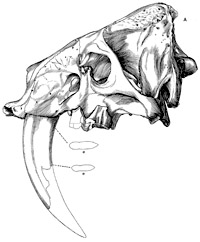Museum, University of Nebraska State

Bulletin of the University of Nebraska State Museum (1924–2023)
Date of this Version
3-1931
Document Type
Article
Citation
Bulletin of the University of Nebraska State Museum 1:19 (Mar. 1931), pp. 163-170.
Abstract
Mastodons and mammoths, represented by their relics, are so frequently exposed by shovel, plow, road grader, dredge, and rains, that they have become household words. They are plainly the commonest and best-known vertebrate fossils. They were fortuitously entombed, and are now accidently found. Their relics, though numerous, never represent the grand total that lived. Indeed, it was a rare individual that fell where circumstances favored rapid interment and consequent preservation; the grand majority fell in the open where their bones suffered rapid and complete decay. The American mastodon occupies a position between the long-jawed, long-skulled, four-tusked ancestor called Palaeomastodon, and the short-jawed, pugged-skull, two-tusked mammoths. The precursors of the mastodons, such as Palaeomastodon, and the tetrabelodons, had two tusks in the upper jaw, and two in the lower, hence, the appropriateness of the name four-tusker, or tetrabelodon. The mastodons, coming next in order, lacked mandibular tusks, but despite this fact an occasional individual reverts, and has lower tusks, as shown in the accompanying cuts. The mandibular tusks were waning inheritances from the past, which plainly required ages for reduction and suppression, and complete elimination was never a reality. From the birth of the race to its final extinction mastodons had not ceased to erupt mandibular tusks. In the majority of jaws, the inferior tusks are wholly wanting; in others the tusks have not been erupted, but lie embedded in the bone; sometimes one or two small tusks are erupted; in still other cases large ones appear. In the case of the short-jawed elephants, such as the mammoth and modern elephants, mandibular tusks are never erupted. The Warren mastodon had a solitary dwarfed tusk in the mandible, and was named Tetracaulodon, and the term might still be used conveniently to designate mastodons possessed of mandibular tusks. The tetracaulodont type of mastodon is not particularly rare, for there are two good examples in Amherst. Hay reported several, and Warren, studying mastodon jaws, found nine of this type. There is one example in the Nebraska State Museum. In the museums of the country many others can doubtless be found. The presence of mandibular tusks in mastodon jaws has been used in determining their sex, those with tusks being males, those without, females.
Included in
Entomology Commons, Geology Commons, Geomorphology Commons, Other Ecology and Evolutionary Biology Commons, Paleobiology Commons, Paleontology Commons, Sedimentology Commons


Comments
Copyright (c) 1931 THE NEBRASKA STATE MUSEUM